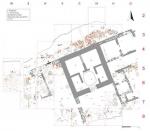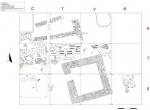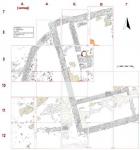Summary (English)
EXPLORATIONS NEAR THE VILLAGE OF KNYAZHEVO (Daniela Agre – daniela.agre@abv.bg, Deyan Dichev) Debris from the roof were discovered in front of the façade of the Central Building and the extension of the wall that began from the southwestern corner of the building was explored. Debris from the roof were discovered to the north of the Central Building. A ceramic vessel, coins and nails were found beneath the debris. In Sector Central, in Trench I5 the exploration of the postern continued. Burned remains from the wooden gate were discovered and iron elements from its construction and facing were found. A sector of the northern fortification wall, up to 1.20 m wide, with a buttress was discovered in Trenches Z5 and I5. The explorations of the tower continued. It measured 6.70 m by 6.80 m and the walls were built in rubble masonry, preserved up to 1.10 m in height. Three fragmentary ceramic vessels, sherds from a Greek amphora, two silver and one bronze coins were found in the tower. The entrance of the tower, 1.20 m wide, was on its western wall. A leveling wall was explored in Trenches S6-8 to the west of the tower and adjoining its northwestern corner. Fragmentary roof-tiles, sherds from Thracian and Greek pottery and slag were found to the south of the leveling wall. The explorations of the ditch, 2.40 m wide and 0.80 – 1 m deep, located at 3 m in front of the eastern fortification wall continued in Trenches U4-6. Sherds, including from Greek amphorae, fragmentary building ceramics and sun-dried bricks, and iron slag were found. In Sector West, in Trenches V7-9 the eastern part of Room 3 and part of the northern fortification wall, up to 1.10 m wide, were discovered. The explorations of Room 2 continued in Trenches B7-10 and slag was found. A wall c. 1.25 m wide, surrounding an outer yard, was discovered in Trenches A8-12 in front of the western fortification wall. In Trenches Z9 and I9-11 a sector of the southern fortification wall and the northern wall of a room were discovered. The finds from the room included fragmentary building ceramics, sherds, two bronze fibulae and a gold stater of Philip III Arrhidaeus. The Thracian royal tyrsis dated to the last quarter of the 4th – beginning of the 3rd centuries BC.
- Daniela Agre - Archaeological Institute with Museum
- Deyan Dichev - Archaeological Institute with Museum
Director
Team
Research Body
- Archaeological Institute with Museum






![Download [PDF]](/excavation/skins/fasti/images/results/download_sml.png)

